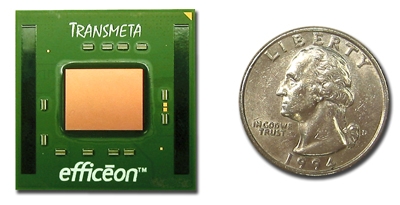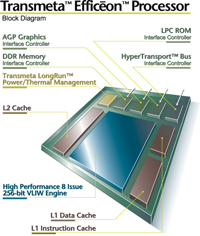NVIDIA nForce3 Go120 and Transmeta Efficeon Preview
by Andrew Ku on October 17, 2003 4:55 PM EST- Posted in
- Laptops
Transmeta Efficeon – Partner through the good and the bad
Transmeta's last chipset partner was ALi, and we didn’t see success by any measure in the North American market. (Though, we hear of use overseas.) NVIDIA is definitely positioned much stronger than ALi, and has the ability to push their product in the marketplace with higher widespread acceptance. However, there is still much that remains to be seen. The Efficeon processor (a play on the word efficient) that was launched just a few days ago is supposed to be the successor to the Crusoe processor, which we saw in FIC’s SlateVision and PaceBook’s PaceBlade.
Transmeta made a name for themselves a few years back with the announcement of the Transmeta CPU, which promised high performance computing with low power consumption. The x86 compatible processor was to combine hardware and "code morphing" software to allow the VLIW (Very Long Instruction Word) Crusoe to understand x86 commands. The benefits: a smaller CPU package that consumed up to 70 percent less power than competing chips.

Transmeta CPUs have been used in portable computers for some time now and are the processor of choice for ultra-portable systems due to their low power consumption. The market for ultra-portable systems based on the Transmeta CPU seems to be limited to Tablet PCs and PDA-like systems with built in keyboards. The use of them in true ultra-portable notebooks, like the IBM X31, was almost non-existent. This is where Intel picked up with Centrino and was able to create a reasonable performance system with low power consumption.
Compared to Transmeta, the only competing solution a year or so ago to get Windows XP to display a screensaver smoothly was the Pentium III-M, which consumed a good deal of power and emitted a fairly large amount of heat. Centrino and specifically Pentium-M allowed the minimum threshold for performance to be hit and also was able to hit the power consumption and heat emissions that finally rivaled Crusoe.
Transmeta's new CPU makes everything more interesting, because it supposedly can work as the platform for a mainstream notebook. This implication would make it seem that it can competitively rival Pentium-M.
As you may recall, the Crusoe TM5800 (667MHz – 1.1GHz) includes 128K of L1 cache and 512K of 4-way set associative write back L2 cache. The chip also includes an integrated northbridge, providing DDR or SDR SDRAM support as well as a PCI controller and a southbridge interface. The new Efficeon TM8600 processor (1.1GHz) includes 192K of L1 cache and 1MB of 8-way set associative write back L2 cache. The new chip is also based on a .13 micron manufacturing process and includes an integrated northbridge, providing DDR support and AGP controller and a HyperTransport interface.
It is interesting to note that nForce3 Go was clearly designed as a derivative of nForce3 and therefore was originally meant for Athlon64. This is why nForce3 Go has an integrated AGP controller. But because Athlon64 and Efficeon have integrated northbridges and use HyperTransport as their external link, there are two AGP controllers between nForce3 Go120 and Efficeon.
Future versions of Efficeon processors are to be based on the .09 micron manufacturing process, which is expected to materialize sometime next year. In the news, Transmeta is touting their performance as 50% to 80% faster than the Crusoe processor. How much performance the Efficeon processor actually brings will need to wait till we get an in lab system.
ALi didn't gain much from the Transmeta relationship because the Crusoe didn't sell in large volumes. This time around, the success of NVIDIA's nForce3 Go120 is directly tied to Transmeta's new processor and vice versa. Though, NVIDIA will rely on Transmeta more heavily because there are other southbridge providers, such as ALi.











1 Comments
View All Comments
Anonymous User - Tuesday, October 21, 2003 - link
(Re: nVidia+Transmeta)"Since that addition typically falls outside this focus, we currently don't see optical drives in ultraportable notebooks."
I'm surprised; this article was published 10/17/03, but the writer obviously hasn't been paying attention to the ultraportable market the past couple of years if the Fujitsu P-2000 series and current successors (P-5000, Sony TR1/2, etc.) don't receive a mention.